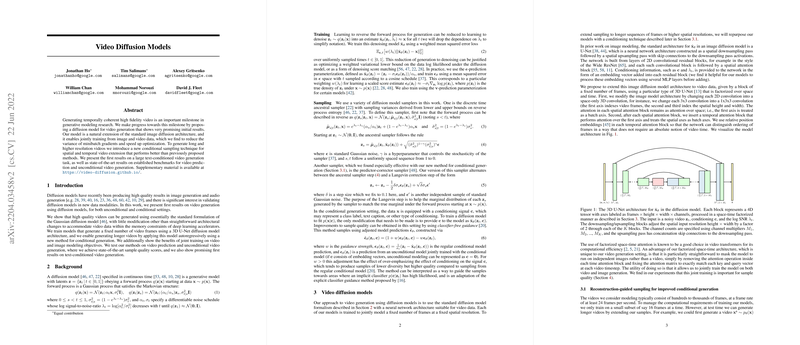Video Diffusion Models: A Detailed Review
Introduction
The paper "Video Diffusion Models" addresses the challenge of generating temporally coherent, high-fidelity video sequences using diffusion models. As an extension of image diffusion architectures, the proposed model leverages joint training from both image and video data to enhance the robustness of gradient estimation and expedite optimization. This work presents novel conditional sampling techniques enabling the generation of extended and higher-resolution video sequences, setting new benchmarks in multiple video generation tasks such as text-conditioned video generation, video prediction, and unconditional video generation.
Core Contributions
The paper's key contributions include:
- Extension of Diffusion Models for Video Data: The research extends Gaussian diffusion models to handle video data. By adapting the standard image diffusion architecture, the authors propose a 3D U-Net architecture that accommodates video sequences within deep learning accelerators' memory constraints.
- Joint Training on Video and Image Data: The model benefits significantly from joint training on both video and image data, effectively reducing the variance of minibatch gradients, thereby speeding up the optimization process.
- Novel Conditional Sampling Techniques: The introduction of a new conditional sampling technique, referred to as reconstruction guidance, enhances the performance in generating longer and higher-resolution videos compared to previous methods.
- State-of-the-Art Results: The model achieves state-of-the-art results in multiple established benchmarks, including video prediction and unconditional video generation. It also presents initial promising results in text-conditioned video generation.
Model Architecture
The core architecture proposed is a 3D U-Net with space-time factorization. This design employs the following key elements:
- Spatial and Temporal Attention Blocks: The architecture incorporates spatial downsampling followed by upsampling, accompanied by skip connections. Each layer is designed using 3D convolutional residual blocks, and temporal attention blocks are inserted following each spatial attention block for efficient video data processing.
- Joint Training Mechanism: The model is masked to handle independent images correctly, allowing joint training on video and image generation tasks. This significantly improves the sample quality since the gradient estimation benefits from the inclusion of additional independent images.
Sampling Techniques
The paper elaborates on sampling techniques crucial for extending sequences both spatially and temporally:
- Ancestral Sampler: This approach involves a Monte Carlo method derived from variational lower bounds to approximate the reverse process of the forward Gaussian process.
- Reconstruction-Guided Sampling: This novel technique enhances conditional sampling by adjusting the denoising model to approximate the conditional distribution more effectively than existing methods. It uses a form of gradient guidance based on the reconstruction of the conditioning data.
Experimental Results
Unconditional Video Generation
The proposed model sets a new benchmark on the UCF101 dataset, demonstrating superior performance compared to previous methods. The achieved FID and IS scores highlight the generative quality improvements contributed by the model.
Video Prediction
Evaluations on the BAIR Robot Pushing and Kinetics-600 datasets underscore the effectiveness of the model in video prediction tasks. The results show significant improvements over previous state-of-the-art methodologies, particularly when utilizing the Langevin sampler, which further smoothens the generative process.
Text-Conditioned Video Generation
The model demonstrates its applicability to text-conditioned video generation, leveraging classifier-free guidance to enhance sample fidelity and diversity. The inclusion of joint training further bolsters performance, as evidenced by improved FVD, FID, and IS scores.
Implications and Future Work
The practical implications of this research are manifold:
- Enhanced Video Editing and Content Creation: The ability to generate high-fidelity, temporally coherent video can significantly impact various creative industries, including film and animation.
- Real-time Video Prediction: Enhanced video prediction models have potential applications in robotics and autonomous systems, where anticipating future frames can improve navigational and operational efficacy.
The paper also opens avenues for future research:
- Extending Conditional Generation: Future work can explore conditional generation beyond text prompts to include audio or other modalities.
- Bias and Ethical Considerations: The societal implications and potential biases inherent in the generative models warrant extensive auditing and evaluation, ensuring the responsible use of the technology.
Conclusion
By proposing a robust diffusion model architecture for video generation, incorporating innovative conditional sampling techniques, and demonstrating state-of-the-art results across several benchmarks, this paper makes a significant contribution to the field of generative modeling. Future exploration can further optimize these models' practical applications while addressing ethical considerations, thereby ensuring that technological advancements yield positive societal impacts.
